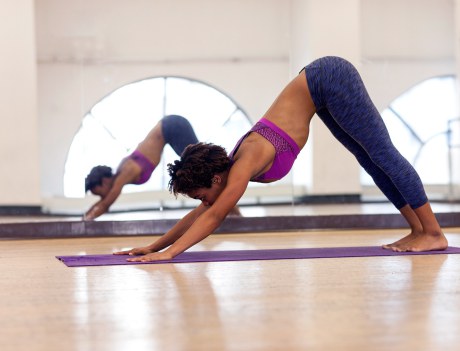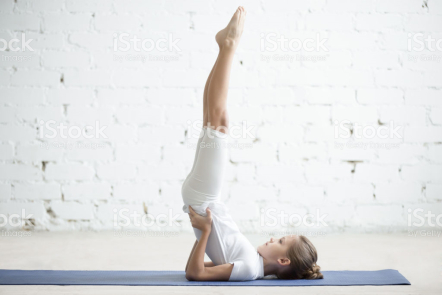One of the major things that intrigued me about yoga was the gravity-defying yoga poses these practitioners could do, and with such ease at that. This interest had me take the plunge to begin a yoga practice. Little did I realize the benefits (and risks) there were to these invigorating poses. Now, I am able to practice Adho Mukha Vrkasana (Handstand) – maybe not as well as others but I have fun being upside down and taking on another perspective of the world.
Inversions, also known as viparita karani in Sanskrit, create an active reversal in which the entire body is benefited, “thereby toning the vital organs, stimulating the endocrine glands, and promoting the balanced and efficient functioning of our entire physiology” (Yoga for Wellness, pg. 98). For an asana to be considered an inversion the head must be below the heart. Those who suffer from glaucoma, high blood pressure, or have had a recent stroke should avoid inversions. Common inversions are Adho Mukha Svanasana (Downward Dog), Sarvangasana (Shoulder Stand), and Salamba Sirsana (Headstand). Kraftsow states,
“Inversion postures also build strength and elasticity in the superficial and deep musculature, ligaments, and connective tissues of the spine and rib cage; and they strengthen the diaphragm and abdominal muscles, as well as the muscles that bind the shoulder and pelvic girdles to the spine. Like extension postures, inversions help improve our posture and overall structural integration, reducing stress to the musculature and organs of the torso, and improving digestion, respiration, and circulation.” (Yoga for Wellness, pg. 98)

With all biomechanics of movement in Viniyoga, inversions have two intentions. The primary intention for inversions is to “achieve the active reversal effect” (pg.98). The secondary intention for inversions is to “strengthen the musculature of the torso, improving the functional integration of the spinal curves and deepening the respiratory rhythms” (pg.98).
What is the key to active reversal?According to Gary Kraftsow, the key to active reversal is “the ability to remain in the inverted posture for a length of time without stress to the structure.” In order to statically hold inversions, we need to maintain the natural curves of the spine with the help of the inhale and exhale.
HeadstandWhile practicing headstands, the top of the head is the base, as well as the forearms and hands. Residing roughly 70% of the weight in the shoulders and arms and 30% on the top of the head will prevent cervical (neck) injury.
ON INHALE: “As rib cage expands, lift the shoulders away from the head, lengthening the neck; lift the pelvis away from the rib cage, lengthening the torso; and lift the legs away from the pelvis” (pg. 98).
ON EXHALE: “Use abdominal contraction to influence the lumbar-pelvic relationship, minimizing lumbar lordosis [think of drawing the belly button up and into the ribs] and controlling the position of the legs” (pg. 98).
 Shoulderstand
Shoulderstand
For shoulderstands, the upper back, shoulder girdle, neck, and head all form the base. To avoid hyperextension of the neck and upper back, keep a slight angle between pelvis and legs instead of stacking them right on top of each other – of course when first starting out and progressively adapt.
ON INHALE: “Lengthen the spine and extend the legs away from the pelvis” (pg. 99).
ON EXHALE: “Contract the belly and stabilize the position of the legs” (pg. 99).

Any type of inversion should be practiced with caution so know your limits before starting. Practicing inversions for just a few moments a day will improve your respiration while strengthening the diaphragm, promote healthy circulation, as well as increase overall musculature strength. I typically practice headstands, resting for a few minutes afterward, then practicing shoulderstand. When I first began practicing headstands, I frequently used the wall until I had enough core strength to hold it without support. You can experience a forward fold, twist, or backbend in several inversions once you are established in a constant inversion practice and are well aware of your limits. If you begin to lose concentration and have trouble breathing, slowly come out of the inversion and rest on your back for a few moments. The breath should be calm and the body strong while practicing inversions safely. I hope this encourages you to give inversions a try and see the world from a different view.
Check out this Ekhartyoga.com article for more on inversions –> All About Yoga Inversions
Namaste! Advertisements Share this:




